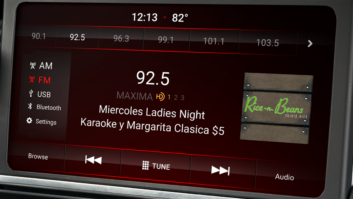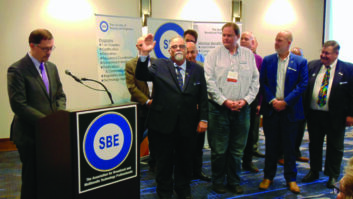Alex Hartman is a partner in Optimized Media Group, which provides broadcast engineering, IT and consulting services; he specializes in the transmission side of the industry and is a vocal advocate of bridging the gap between the IT world and the broadcast facility.
This interview appeared in the Radio World ebook “STLs in the 21st Century.”
Radio World: Alex, how would you describe the current state of studio-to-transmitter links in the United States?

Alex Hartman: It’s a mixed bag. A lot of stations still use 950 MHz STL systems, but as they fail or get retired, they’re being replaced by some form of IP connectivity.
For more traditional licensed 950 MHz links, the scope is pretty narrow, with manufacturers like Moseley, Bext, RVR and a few others that are mostly international offerings that have gone through FCC approval.
But then there are IP-based systems ranging from 2.4 GHz and 5.8 GHz — both ISM/UNII bands, with no licensing — to 6, 11 and 18 GHz licensed; 24 GHz unlicensed; and even 60 GHz unlicensed systems.
The real-time data and reporting about the health of the connection that’s provided by an IP codec is a pretty important metric. Legacy STL systems don’t offer those metrics to help troubleshoot.
By the way we shouldn’t talk about “radio-based” STLs, because be it TDMA, modem or IP, they all use a “radio,” it’s just a matter of modulation scheme and interface.
I do feel the 950 MHz band is coming to an end, with the need for more metadata and other telemetry reporting from the transmitter site, as well as the FCC wanting to repurpose bands for other uses — C-Band and UHF TV for example.
RW: What are the benefits and drawbacks of licensed vs. unlicensed options?
Hartman: The obvious benefits of licensed links are coordination and protections with mediation. Also they tend to have high-level support contracts with specific service level agreements to make sure they always perform in the correct modes and carriers. Unlicensed tends to follow more “industry standard” protocols, and the products can be found in retail stores, making interference a large problem.
In “flyover country,” farm implements, of all things, are interfering with unlicensed bands. Tractors and farm implements are using 2.4 and 5.8 GHz WiFi to communicate. Enough of those on a farm can raise the noise floor significantly and even cause errors on a point-to-point link if your STL traverses overhead.
RW: What are benefits and drawbacks of wired vs. wireless?
Hartman: They all have their pros and cons. Wired is always subject to third-party reliability and also susceptible to backhoe fade or “coarse vehicle adjustments” — cars crashing into poles!
Wireless can suffer interference from other users, path coordination mistakes and urban sprawl issues. Both are susceptible to Mother Nature, of course — the ultimate winner in all games played.
RW: What plotting tools are available to help with STL planning?
Hartman: There are many. If you go licensed wireless, your IP radio provider will typically offer those services as a turnkey. Or something like V-Soft, or radio mobile for the DIY folks. Companies like Ubiquiti offer online pathing tools.
RW: On a Nautel webinar, you and other speakers discussed the Fresnel zone. Why does it matter?
Hartman: Trees, houses, water towers, terrain can all interfere. Wireless is not “fixed width,” the radio waves spread out when they leave the antenna, and the width is frequency dependent. In a point-to-point application, this Fresnel zone must be kept clear for reliable signals to make it back and forth.
In other words, you may be able to “see” the target, but you also have to consider the midpoint surroundings.
RW: What’s the distance limit for radio links? We’ve heard of 60 or even 100 miles or more.
Hartman: There are practical limitations. To select the technology and frequency for a desired application, the height, power, water, terrain, nature and buildings/structures must be considered.
For instance, shooting 18 GHz over a large body of water for more than a few hundred feet can scatter the RF signal enough to make it unusable in the real world, though it should work “in theory.”
Look around at your local zoning. Learn about the growth planning and urban sprawl. A forest today might be high rises in five years, or a highway overpass. Or trees in that forest may grow to infringe on your path.
Going 100 miles or more using IP is possible but not practical. Always follow manufacturer’s direction on distances, and add some margin window to keep you on the air during bad storms, snow, rain and dust.
RW: What impact on IP STLs did the opening of 6 GHz to unlicensed uses cause?
Hartman: The 6 GHz band being opened up to WiFi 6E devices is a mixed bag. For now it’s only indoor devices, and they require AFC technology to keep away from licensed services. But it’s only a matter of time before it’s authorized for outdoor use, and I think it will cause issues for everyone, including the cellular providers, who use 6 GHz links for cell-to-cell communications and backhaul to point-of-presence sites.
RW: Are licensed STL frequencies safe from FCC auctions and changes?
Hartman: Absolutely not. Again, 6 GHz, C-Band, 7 GHz and even UHF TV are all up for grabs. I mentioned that the days of the 950 MHz band are numbered, not only because of usefulness, but being sub-1 GHz will be enticing to the cell providers for next-generation tech. They’ll need 900–1.6 GHz to do it meaningfully. That’s the entire ISM and reserved broadcasting bands.
The FCC has proven time and time again that broadcast has fallen to the wayside in favor of bandwidth-hungry cell providers.
RW: How has the evolution of wireless IP links changed the landscape?
Hartman: It has removed a very expensive barrier to entry for broadcasters to have bidirectional data existing at the transmitter site, allowing for telemetry in real time, offsite data backups, offsite automation systems, even mechanical monitoring and intrusion detection with cameras and security systems. With the copper plant being decommissioned by many telephone companies, you can now also fly over a SIP phone line to the site.
RW: And how have composite FM multiplex codec solutions changed things?
Hartman: They’ve allowed for the last bit of the air chain to be brought back to the studio, minimizing the equipment needed at the transmitter site, reducing risk to other expensive critical air chain devices like processing and HD equipment.
The fewer computers there are in the mostly hostile environment that many transmitter sites tend to be, the better off stations are.
RW: What role are technologies like Starlink satellite, 5G, fiber broadband, LTE and cloud playing?
Hartman: They’re offering a much more diverse selection of pathing between the studio and transmitter sites.
Importantly, though, they also put you in the hands of third parties — big cellular companies in particular — and at their whims of moving things around or causing unknown outages.
In many cases in rural areas, the towers are all linked by other backhaul means to the primary point-of-presence tower, where the large-capacity fiber lines are. So the diversity on the towers is actually not as diverse as one thinks.
These towers can be 40 miles apart, end to end, all using the same fiber connection at the point-of-presence tower via licensed or unlicensed links to adjacent towers.
With fiber, as with the telcos, you’re at their whim and at risk from outages, upgrades and changes.
Starlink is the newest player to the game, which literally opens up a whole new world of connectivity. Keep in mind that it’s still growing and comes with those growing pains. But having low-latency high-speed data to mountaintops or very remote locations opens new possibilities. Putting Starlink on BOTH sides of the link — at the studio and the transmitter site — is in essence a private network. It’s using only the Starlink network, it never touches the ground-based public internet!
Eventually the Starlink system will be another large-scale network — a global network — overlaid on the traditional ground-based system, with points-of-presence to get back to the ground. But if you go terminal to terminal, you never need the wireline carrier part of the system!
Again, there’s still a third party involved, you’re still at their whim. And right now it uses CG-NAT, or Carrier Grade Network Address Translation, meaning that the IP space used cannot have ports opened, VPN hosts, etc.
It does need an intermediary service to make IP connections. It was designed for consumption, not hosting.
RW: What should we know about the state of return links for “telemetry”?
Hartman: This is more important than ever! Copper theft and vandalism are on the rise, so camera and alarms are more and more important — and required for insurance purposes. HVAC systems now can “call home” in case of failure. You can remotely control air inlet/exhaust dampers in case of emergencies if properly equipped, and even fire suppression systems.
Tower light monitoring is now IP-enabled or easily integrated with a site remote control.
You may visit that building only rarely now, so knowing its health can help avoid imminent failures or prompt preventive instead of reactive maintenance. You’ll know what you need to bring to the site instead of making multiple trips.
RW: What best practices for security should engineers keep in mind?
Hartman: Stations should be employing IT professionals for this part or outsourcing to a managed service provider to assist.
Firewalls should be restrictive. Multi-factor authentication should be used for any remote access. And everything should be in some form of VPN.
NEVER! EVER! PORT! FORWARD! If the outside world cannot see it, they cannot get in. VPNs are by nature encrypted. The firewall employed should NOT be something you can order off Amazon for 50 bucks or pick up at the local big box stores.
Competent systems are moderately expensive and require subscriptions to maintain current lists of malicious threats. Fortinet, Palo Alto, SonicWall are all reputable brands and available with these features.
Deploy intrusion prevention and detection software and even some AI metric detection for “abnormal behaviors.” Speaking of proactive redundancies, any good enterprise should have two firewalls operating in “high-availability” or HA mode, to allow in-place updates and upgrades to assure continuous operation of the business.
Of course external threats are only one type; the other is on the inside. Personal laptops, USB drives, downloading suspicious audio files, all can make for a bad day. Again: Employ an MSP or IT professional on those specifics.
In general, IT security is at the forefront for every broadcaster. Insurance companies are refusing compensation for negligence against ransomware. They’re asking you to “prove you tried” with outlines for security protocols, equipment used and measures taken.
Companies that do manage to get access to a policy are often price-adverse to the premiums and decide to run the risks. Sticker shock sets in. But insurance is pretty cheap compared to the value of your company.
RW: What further developments should we be watching for?
Hartman: Single data carrier encapsulation like SRT, or Nautel’s development involving HD Radio as well as analog composite MPX encapsulation, are going to eliminate the need for other devices at the transmitter site, to allow diversity and maintain high availability to the transmitter directly.
Also look to the IT sphere with an open mind. See how Amazon and Azure do what they do, then ask if you can apply it to audio or video. Chances are, yes, yes you can. Audio is such a low throughput or bandwidth “ask” compared to everything else these days. Streaming a Netflix movie to your iPad is the same as four stereo audio streams with ancillary data!
RW: Anything else we should know?
Hartman: The world went IP. The vast majority of traditional STL companies are just now getting there. IP should be your future, from audio to email. But broadcasters are still newcomers to the established IT infrastructure business. There’s a whole new world to learn, and engineers who are set to retire most likely do not want to learn it. A business that relies on IP needs to have a competent IT team to maintain a facility. IT includes backups in their designs, whereas broadcast builds backups AFTER a failure happens. Broadcast needs to get serious about this part. If you’re still storing your entire music library on the on-air computer, stop. If you’re still using DOS-based programs for daily business, stop. If you’re still using the free version of Adobe Audition or Cool Edit, stop. Windows XP? STOP.
Like it or not, IT does not have the shelf life of an old Continental transmitter; it has to be updated and refreshed constantly. Invest in your IT future or get left behind like so many others who failed to pivot.
Read more interviews on this topic in the free ebook “STLs in the 21st Century.”







